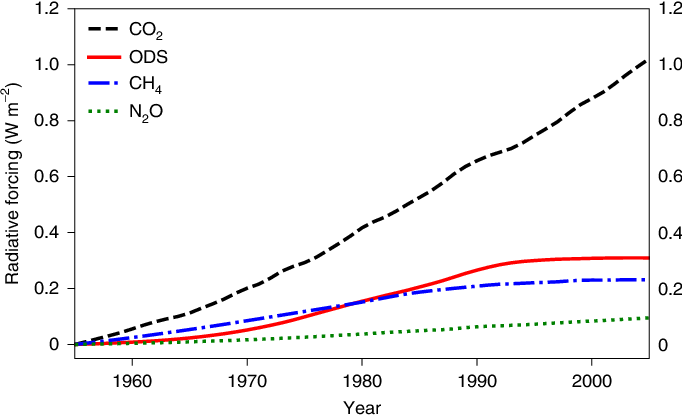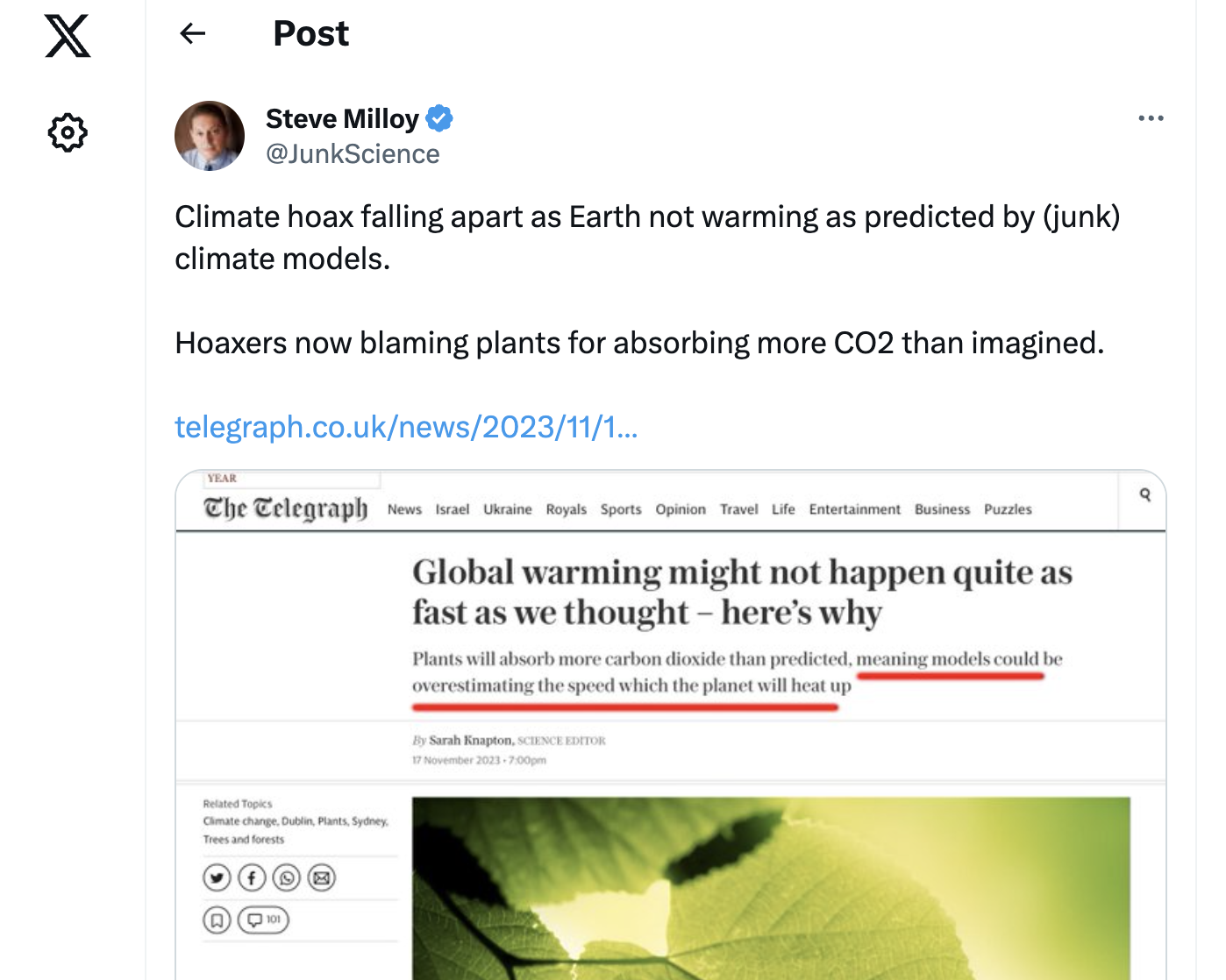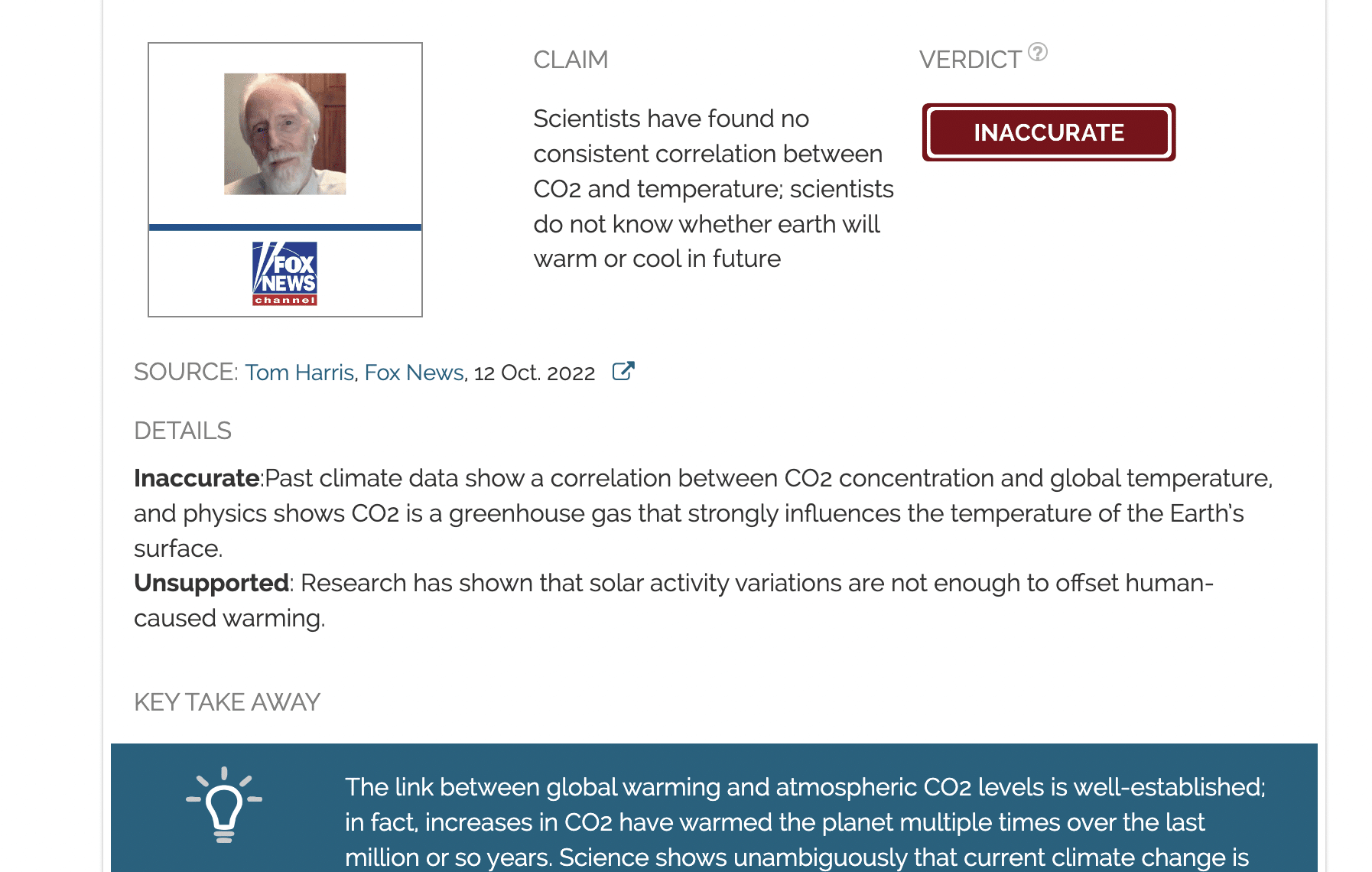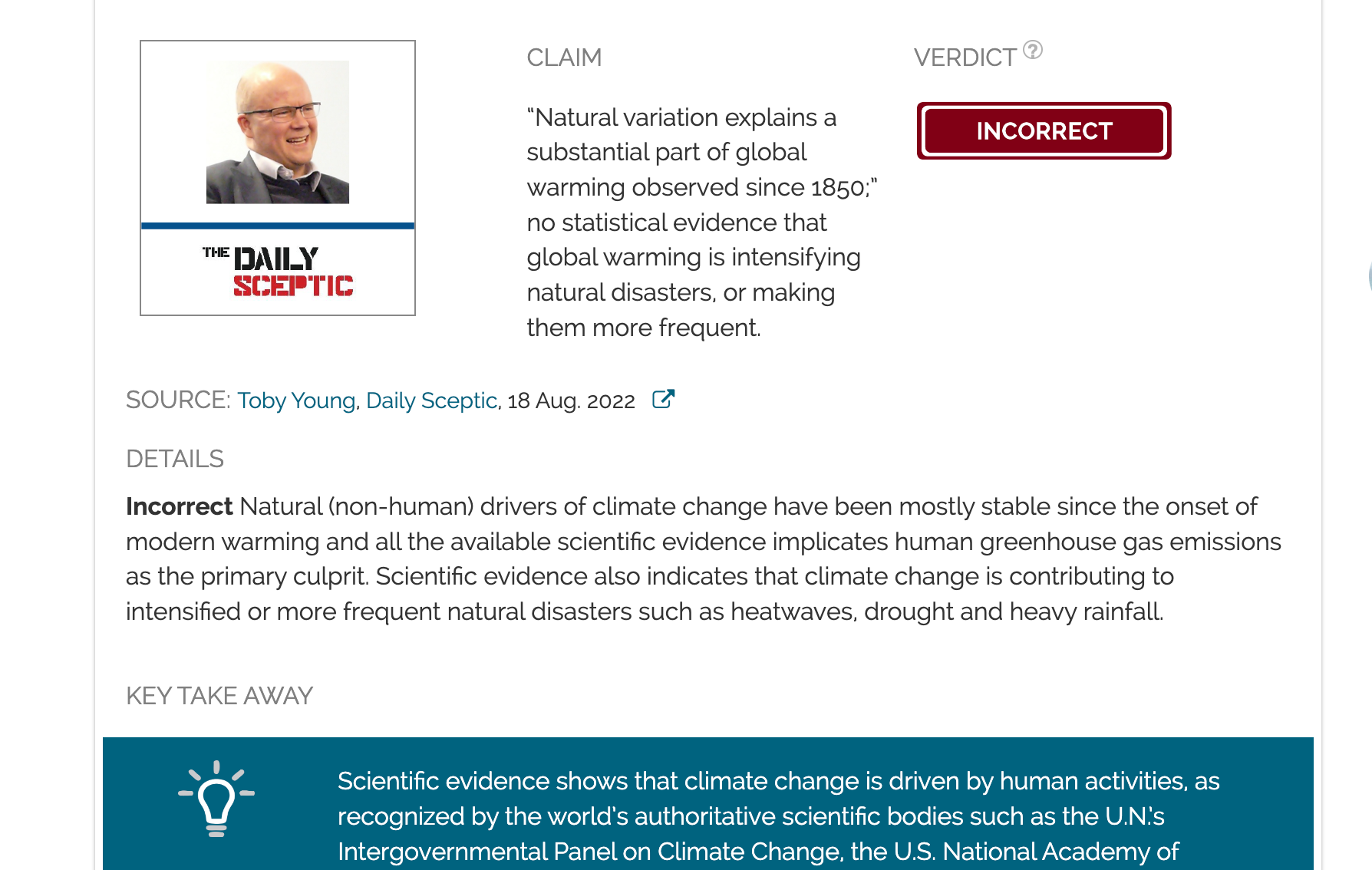- Climate
YouTube video falsely claims that climate models systematically over-estimated warming and that we are heading towards an ice age
Key takeaway
Climate scientists use models to simulate Earth's climate system and project the rate of global warming caused by human activities. State-of-the-art climate models have successfully forecasted global average surface temperatures over the past few decades.
Reviewed content
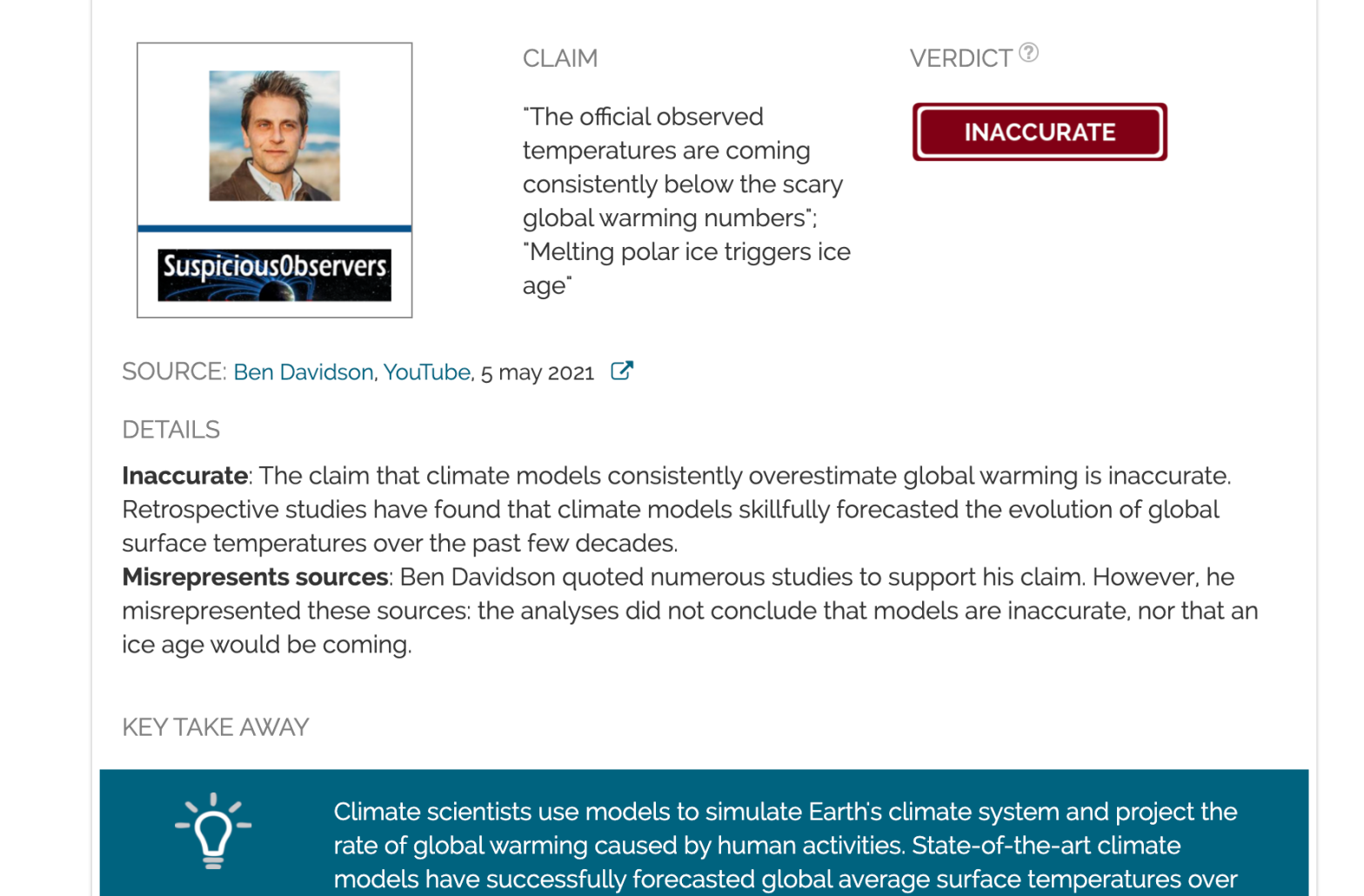
Verdict:
Claim:
"The official observed temperatures are coming consistently below the scary global warming numbers"; "Melting polar ice triggers ice age"
Verdict detail
Inaccurate: The claim that climate models consistently overestimate global warming is inaccurate. Retrospective studies have found that climate models skillfully forecasted the evolution of global surface temperatures over the past few decades.
Misrepresents sources: Ben Davidson quoted numerous studies to support his claim. However, he misrepresented these sources: the analyses did not conclude that models are inaccurate, nor that an ice age would be coming.
Full Claim
"The official observed temperatures are coming consistently below the scary global warming numbers"; "Models fail to predict the future and the past due to bias, uncertainties, questionable data and unappreciated natural forcing"; "Melting polar ice triggers ice age"
The claim that climate models fail to predict the future or reproduce the past was published in a YouTube video by Ben Davidson on his channel, Suspicious0bservers, which has more than 500,000 subscribers. This video has been watched more than 57,000 times since it was published on May 5, 2021.
In the video, Davidson makes numerous false claims about climate models as explained in this review. He shows screenshots of titles and abstracts from recent climate science publications, which he misinterpreted to support his conclusion.
The core claim of the video is that “At no point have the climate models accurately predicted the future. The official observed temperatures are coming consistently below the scary global warming numbers”. However, this claim is contradicted by the fact that scientists found climate models skillfully forecast the evolution of global surface temperatures over the past few decades (see a previous Climate Feedback review here).
For example, a 2019 study by Hausfather et al. found that climate models published between 1970 and 2007 “were generally quite accurate in predicting global warming in the years after publication, particularly when accounting for differences between modeled and actual changes in atmospheric CO2 and other climate drivers”[1] (read scientists’ comments below for further information).
To support his claim that scientists overestimate global warming, Davidson argues that climate models are too sensitive to CO2, which means that the increase in global temperature forecasted for a given increase in atmospheric CO2 concentration is too high. Davidson refers to a 2020 study by Zhu et al. which shows that a recent climate model doesn’t accurately forecast past temperatures from the Eocene (50 millions years ago), predicting much warmer temperatures at the time than expected[2].
Scientists understand that some, but by no means all, of the most recent climate models show a high equilibrium climate sensitivity, which is defined as the long-term response of global mean surface temperature to a doubling of atmospheric CO2 concentrations[3]. This sensitivity to CO2 is poorly constrained, with a likely range of 1.5°C to 4.5°C, according to the IPCC Fifth Assessment Report. It’s a fact that some of the latest climate models have a sensitivity higher than 4.5°C, with values up to 5.6°C[3, 4].For example, the model tested in the Zhu et al. study has a sensitivity of 5.3°C. As a result, these models simulate stronger warming and have difficulties reproducing the observed warming trend. However, according to a 2020 study by Tokarska et al., this is the case for only a third of the models participating in the Sixth Coupled Model Intercomparison Project (CMIP6), which will form the basis for the upcoming Sixth Assessment Report of the IPCC[3]. Conversely, other CMIP6 models with climate sensitivity values that are within the IPCC likely range show global warming trends that are consistent with past global temperature observations. Moreover, as this study shows, “projected future warming is correlated with the simulated warming trend during recent decades, enabling us to constrain future warming based on consistency with the observed warming”. The study concludes that, taking this into account, “observationally constrained CMIP6 warming is consistent with previous assessments based on CMIP5 models”.
Later on in the video, Davidson claims that, “recently half of Arctic warming was blamed on ozone loss… It told us that the heat that has been blamed on carbon all these years is a fantasy”. To support his claim that CO2 is actually not responsible for global warming, he displays a 2020 paper by Polvani et al. demonstrating that chemicals that destroy the ozone layer, such as chlorofluorocarbon (CFC’s), contributed to warming in the Arctic[5].
While it is true that these ozone depleting substances have the potential to warm the atmosphere, their effect on Arctic temperatures is weaker than the one induced by CO2 rising concentration, contrary to Davidson’s interpretation. As the authors of the study warn, “it is important to place ozone depleting substances in the context of the other anthropogenic forcings. The largest radiative forcing is associated with CO2, and it is three times larger than the radiative forcing from ozone depleting substances, over the 1955–2005 period” (see the figure below). Radiative forcing (RF) describes the net change in the energy balance of the Earth system in response to some imposed perturbation (for example, a change in CO2 concentration in the atmosphere). It is expressed in watts per square meter and averaged over a period of time, with positive RF leading to a warming and negative RF to a cooling. Radiative forcing is valuable for comparing the influence on global mean temperature of most individual agents affecting Earth’s radiation balance (e.g. specific greenhouse gases, aerosols, solar irradiance).
Figure 1—Radiative forcing of greenhouse gases for 1955-2005. From Polvani et al. (2020)[5]
Another misleading claim made by Davidson is that “the data itself has come under major questions by the world’s number one climate journal… The urban heat island effect adds on a major source of doubt…”. In this statement Davidson is suggesting that the rise in global temperature recorded is inaccurate and biased by the fact that temperatures are “naturally” getting higher in the cities due to urbanization. According to him, global warming is thus overestimated. He relies on a study by Zhang et al. published in March 2021 in Journal of Climate that quantifies the urbanization contribution on global land annual mean and extreme temperature records[6].
Cities do experience much warmer temperatures than nearby rural areas, especially at night or in winter, because urban building materials trap heat. This phenomenon is called Urban Heat Island (UHI). This urbanization effect influences temperature measurements locally, and scientists are well-aware that it needs to be properly identified and removed in temperature data series in order to ensure that global warming is accurately measured and not overestimated. According to the IPCC Fifth Assessment Report, “global adjusted data sets likely account for much of the UHI effect present in the raw data”[7]. Overall, adjustments to temperature data reduce the apparent global warming. At the global scale, the IPCC report argued that the uncorrected urbanization influences contribute no more than 10% to the centennial global land averaged temperature trends. As described in Zhang et al., “the urbanization effect on the trends of annual mean and extreme temperature indices series in East Asia is generally the strongest, which is consistent with the rapid urbanization process in the region over the past decades, but it is generally small in Europe during the recent decades”.
After discrediting climate models predicting future global warming, Davidson claims that “the changes we are seeing are going to trigger an ice age. Melting the ice at the pole affects the heat transport in the ocean and triggers rapid cooling towards ice-age conditions”. He cites a study by Starr et al. published in January 2021 that links the melting of Antarctic icebergs and the onset of glacial periods[8]. This claim is inaccurate and misrepresents the results of the study it is based on. As discussed below by Ian Hall, from Cardiff University, a co-author of the study, the study’s conclusion doesn’t apply in the warm conditions we are currently experiencing. On the contrary, the natural rhythm of ice age cycles may be disrupted as the Southern Ocean will likely become too warm for Antarctic icebergs to travel far enough to trigger the changes in ocean circulation required for an ice age to develop. This pattern is the exact opposite of the claim made by Davidson.
The second part of the video is devoted to the claim that “climate has much more to do with sun, volcanoes and cosmic rays modulation than is allowed in the climate models”. This statement is inaccurate as there is strong evidence that solar forcing cannot explain much of the observed warming at all (see below , and previous Climate Feedback reviews here and here).
Scientist’s Feedback
“At no point have the climate models accurately predicted the future”

Director of Climate and Energy, The Breakthrough Institute
[Comment from a previous evaluation of a similar claim]
While models can never be a perfect representation of the Earth’s system, they do an excellent job of reproducing many aspects of the Earth’s climate, from rainfall and wind patterns to storm and hurricane formation and warming of the climate. In a 2019 paper we evaluated the performance of 17 historical climate model projections published between 1970 and 2001[1]. We found that 10 of those 17 projected a rate of future temperature change nearly identical to what actually happened in the real world in the years after they were published, while four of the models projected too much warming and three models too little warming[1]. This is particularly impressive for the 1970s-era models, which were published at a time when evidence of observed global warming was limited (and some even thought – based on limited observations – that the world was modestly cooling).
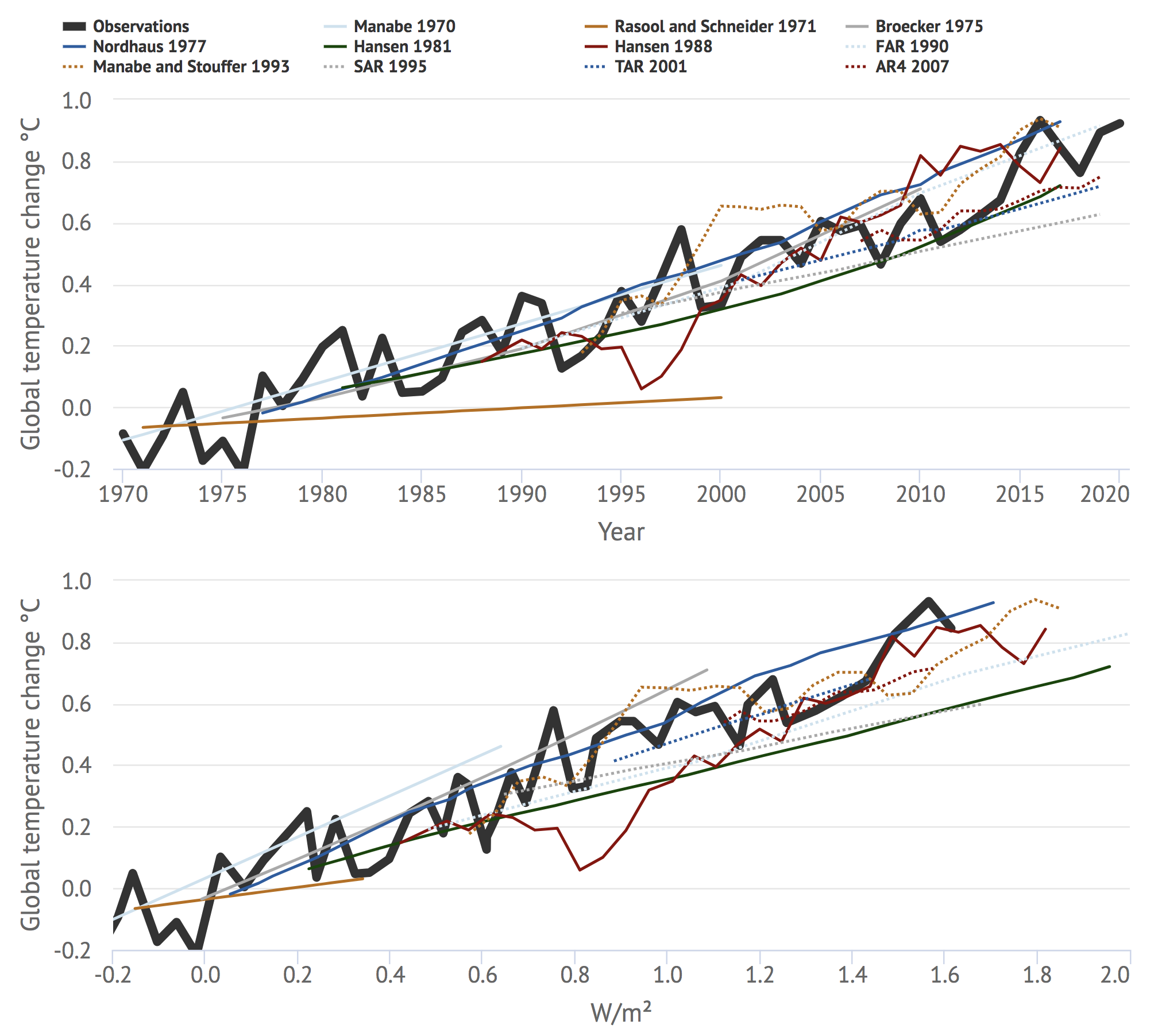
Figure 2—Observed surface temperature change (HadCRUT5 – black line) compared to climate model projections from the years after the model was published (colored lines). Adapted from Hausfather et al. 2019 [1].
“Oversensitivity to CO2”
[Comment from a previous evaluation of a similar claim.]
We and others have shown recently that almost all of the high climate sensitivity models in fact tend to overestimate recent warming[3], and taking that into account suggests that many of the new CMIP6 models are biased high, and that future warming is similar to what it was in earlier models. While it is correct that we are seeing models with high climate sensitivity, the evidence is growing that there are issues with at least some of these models.
[Comment from a previous evaluation of a similar claim.]
It is correct that the most recent versions of some climate models estimate more warming for a given increase in CO2 concentrations. It is also correct that how clouds are represented in these models is the likely reason for these higher estimates. However, it does not report all the science available on this topic and its claims are thus misleading. Available studies that have looked at what these new model projections mean have found that models with higher warming are worse in capturing global warming trends over the past decades, making their projections of very high warming less probable[9]. This is an important context that was omitted.
[Comment from a previous evaluation of a similar claim.]
The most advanced, state-of-the-art predictions of the sensitivity of Earth’s climate to increasing carbon dioxide are based on multiple lines of evidence: observations, the paleoclimate record, theory, and models of varying complexity[10]. Based on this evidence, climate scientists estimate a likely range of the planetary warming resulting from a doubling of atmospheric carbon dioxide: 2.6-3.9 C (or 4.7-7 F). Climate models produce a wider range of the severity of planetary warming in response to increasing carbon dioxide[11]. This is primarily because their simulation of cloud processes is highly variable, with some models performing better or worse than others. However, a variety of independent evidence taken together reveals how clouds throughout the planet will likely behave as the climate warms, allowing scientists to predict future temperature changes with more precision than climate models simulate[10].
“Data itself has come under major questions”

Senior Scientist, Woods Hole Research Center
[Comment from a previous evaluation of a similar claim]
Adjustments are made for good reasons. One of the most common ones is to account for a station located in a growing city, where the urban heat island effect would add spurious warming. In most cases the adjustments reduce, not increase, the warming in the record.
Scientist, University of Bonn, Germany
[Comment from a previous evaluation of a similar claim]
The adjustments are scientifically important, but rather modest for the global mean temperature.The adjustments make the estimated warming smaller, not larger. Below are, for example, the raw and adjusted warming signals of the NASA GISS dataset. The how and why is discussed in this post. For example, if the surrounding of a station becomes more urban this often causes a warming that is local and needs to be removed to estimate the amount the world has truly warmed.
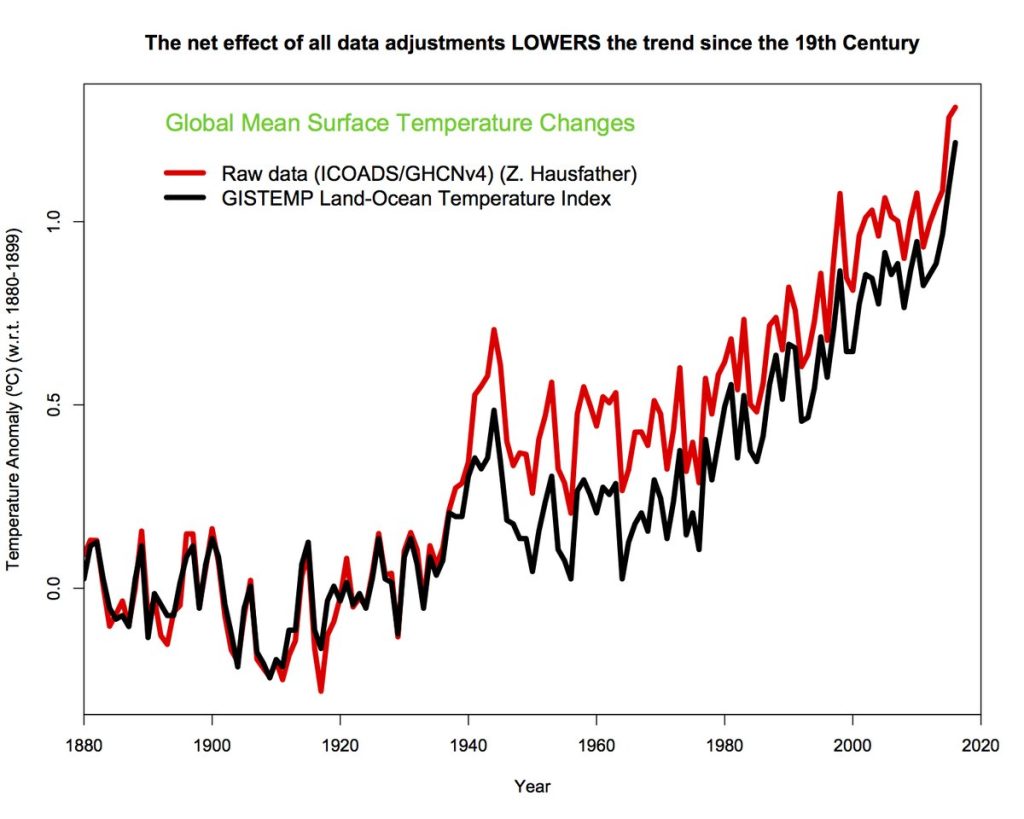
Figure 3— Evolution of raw (red line) and adjusted (black line) temperatures. From Gavin Schmidt.
“The changes we are seeing are going to trigger an ice age”

Professor, Cardiff University
[Comment from a previous evaluation of a similar claim]
Our paper is unambiguous and not relevant for modern/future climate change in this way, and reporting it as so is fundamentally misinterpreting our findings. In fact, in the press release for the study, we emphasise that our findings are specifically related to natural “Milankovitch” cycles in orbital forcing, however with current human greenhouse-gas emissions and increasing global temperatures, the Southern Ocean is likely too warm for icebergs to be transported as described in the paper and melt in the regions necessary for the chain of events we highlight to be triggered. Our study does not say or imply that an ice age is coming. It does emphasise the importance of understanding iceberg trajectories and melt patterns in developing the most robust predictions of their future impact on ocean circulation and climate.
Moreover, it is well established that the onset of a glacial period has only ever, and can only ever, occur when atmospheric CO2 is below a certain threshold. When atmospheric CO2 concentration is too high, the orbital forcing which favours an ice age is simply not enough to cause an ice age. Under the current orbital configuration, a CO2 concentration of below pre-industrial levels would be required for an ice age to begin[12].
“The climate has much more to do with sun, volcanoes and cosmic rays modulation”
Assistant Research Professor, University of Minnesota
[Comment from a previous evaluation of a similar claim]
This is easily disproven. Solar variability does not exert warming that matches observed temperature increases. See US National Climate Assessment 4, Figure 2.1 below.
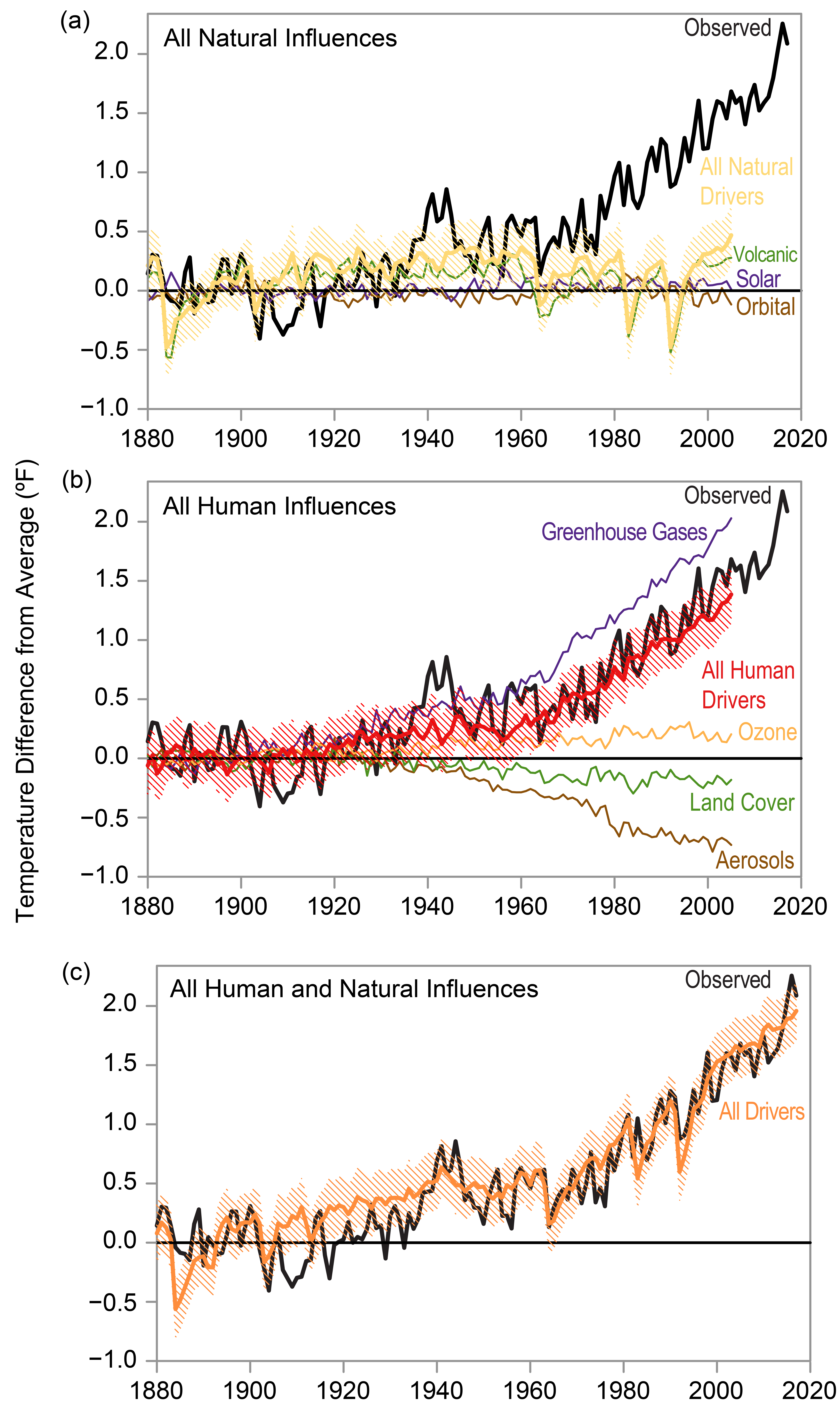
Figure 4— Human and natural influences on global temperatures. From US National Climate Assessment.
REFERENCES:
- 1 – Hausfather et al. (2019) Evaluating the Performance of Past Climate Model Projections. Geophysical Research Letters.
- 2 – Zhu et al. (2020) High climate sensitivity in CMIP6 model not supported by paleoclimate models. Nature Climate Change
- 3 – Tokarska et al. (2020) Past warming trend constrains future warming in CMIP6 models. Science Advances.
- 4 – Meehl et al. (2020) Context for interpreting equilibrium climate sensitivity and transient climate response from the CMIP6 Earth system models. Science Advances.
- 5 – Polvani et al. (2020) Substantial twentieth-century Arctic warming caused by ozone-depleting substances. Nature Climate Change.
- 6 – Zhang et al. (2021) Urbanization Effects on Estimates of Global Trends in Mean and Extreme Air Temperature. Journal of Climate.
- 7 – IPCC Fifth Assessment report. Observations : Atmosphere and Surface.
- 8 – Starr et al. (2021) Antarctic icebergs reorganize ocean circulation during Pleistocene glacials. Nature.
- 9 – Andrews et al. (2020) Historical simulations with HadGEM3‐GC3.1 for CMIP6. Journal of Advances in Modeling Earth Systems.
- 10 – Sherwood et al. (2021) An Assessment of Earth’s Climate Sensitivity Using Multiple Lines of Evidence. Review of Geophysics.
- 11 – Zelinka et al. (2020) Causes of Higher Climate Sensitivity in CMIP6 Models. Geophysical Research Letters.
- 12 – Tzedakis et al. (2012) Determining the natural length of the current interglacial. Nature Geoscience.

